This Karpatka recipe is an amazing Polish Carpathian mountain cream cake that consists of two layers of choux pastry and delicious pastry cream in between. Dusted with powdered sugar, the choux pastry that puffs up unevenly in the oven represents the Carpathian mountains. It’s so delicious and decadent, with just the perfect sweetness.

Jump to:
Ingredients and substitutes
Flour - I use all-purpose flour but you can use pastry flour if you like to make this cream puff cake.
Cornstarch - Cornstarch has no aftertaste and it doesn't affect the texture or the color of the cream. However, some people prefer to use a blend of flour and starch, while others replace it with potato starch.
Eggs - We need three whole eggs at room temperature to make choux pastry for Polish Carpathian cake and 4 egg yolks to make the cream. If you don’t know where to use egg whites, check my Meringue cookies recipe.
Milk and water – For the choux pastry, we need whole milk and water. However, you can use only water if you like. As for the pastry cream, we need whole milk which you can’t replace with anything else.
Vanilla extract and salt – I add these to the pastry and cream to make the flavors more interesting.
Butter – We need unsalted butter for the dough as well as for the cream. Although the temperature of the butter for the dough doesn’t really matter because you’re going to melt it together with the milk and water, the cream calls for room temperature butter.
Sugar – I use granulated sugar for the dough and cream and powdered sugar to decorate the cake.
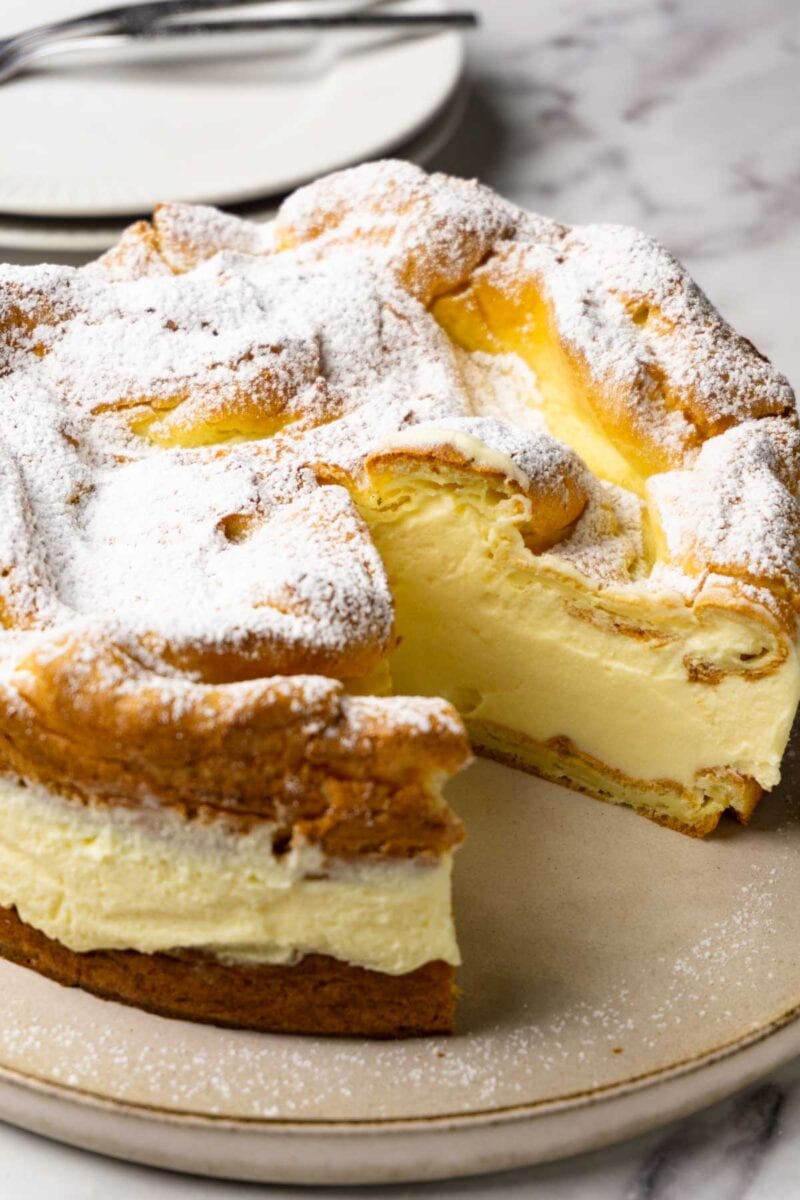
Cooking tips
Use a digital kitchen scale for the best results. Measuring the ingredients in cups is not the best way to approach baking projects.
Preparation is key! You think that this recipe is complicated because it has a lot of steps. I assure you, the cooking itself takes a maximum of one hour if you’ve prepared all your ingredients in advance.
Cool down your pastry cream in a large, shallow dish. The larger the surface, the faster your cream comes to room temperature.
Put your pastry cream in a fridge for 30 minutes to 1 hour to speed up the cooling process, but don’t overdo it. If the cream becomes too cold, you need to let it sit at room temperature to warm it up.
Use an instant-read thermometer to check your pastry cream and butter temperature. They should be approximately the same temperature to combine well into mousseline cream. If your pastry cream is too warm, it will melt the butter and your cream will turn out runny instead of fluffy and stable. If your pastry cream is too cold, it will make your butter hard right away when it touches it, meaning the butter will appear grainy. So either use a thermometer or make sure that your pastry cream sits at room temperature for a good amount of time.
Make your pastry cream ahead of time. If you’re worried that your mousseline cream won’t turn out right, cook the pastry cream in the evening and let it sit at room temperature overnight. Next morning you can continue baking and assembling our delicious Karpatka cake.
Whisk vigorously. When making pastry cream, the mixture can look lumpy as it thickens up. If that’s happened, don't panic and whisk vigorously. Use your muscles! The lumps will dissolve if you continue whisking. For that reason, I highly recommend using a metal whisk, as a rubber whisk can be too soft to break the lumps.
No mixer - no problem. If you don't have a stand mixer or a hand mixer, you still can make Karpatka cake. Use a wooden spoon to mix the eggs into the dough. Yes, it will take more time, but mixing with a machine or with a wooden spoon won't make any difference in the texture of your choux pastry!
Step by step directions
For the dough
1. Preheat the oven to 200C/390F and prepare a 23cm/9-inch springform pan by lining the bottom with parchment paper and greasing the sides with cooking oil or butter.
2. Combine water, milk, unsalted butter, sugar, salt, and vanilla extract in a medium saucepan, then heat over medium heat until it starts simmering.
3. Remove from the heat and add the flour. Mix until no dry flour is left and bring back to the heat. Set it to low.
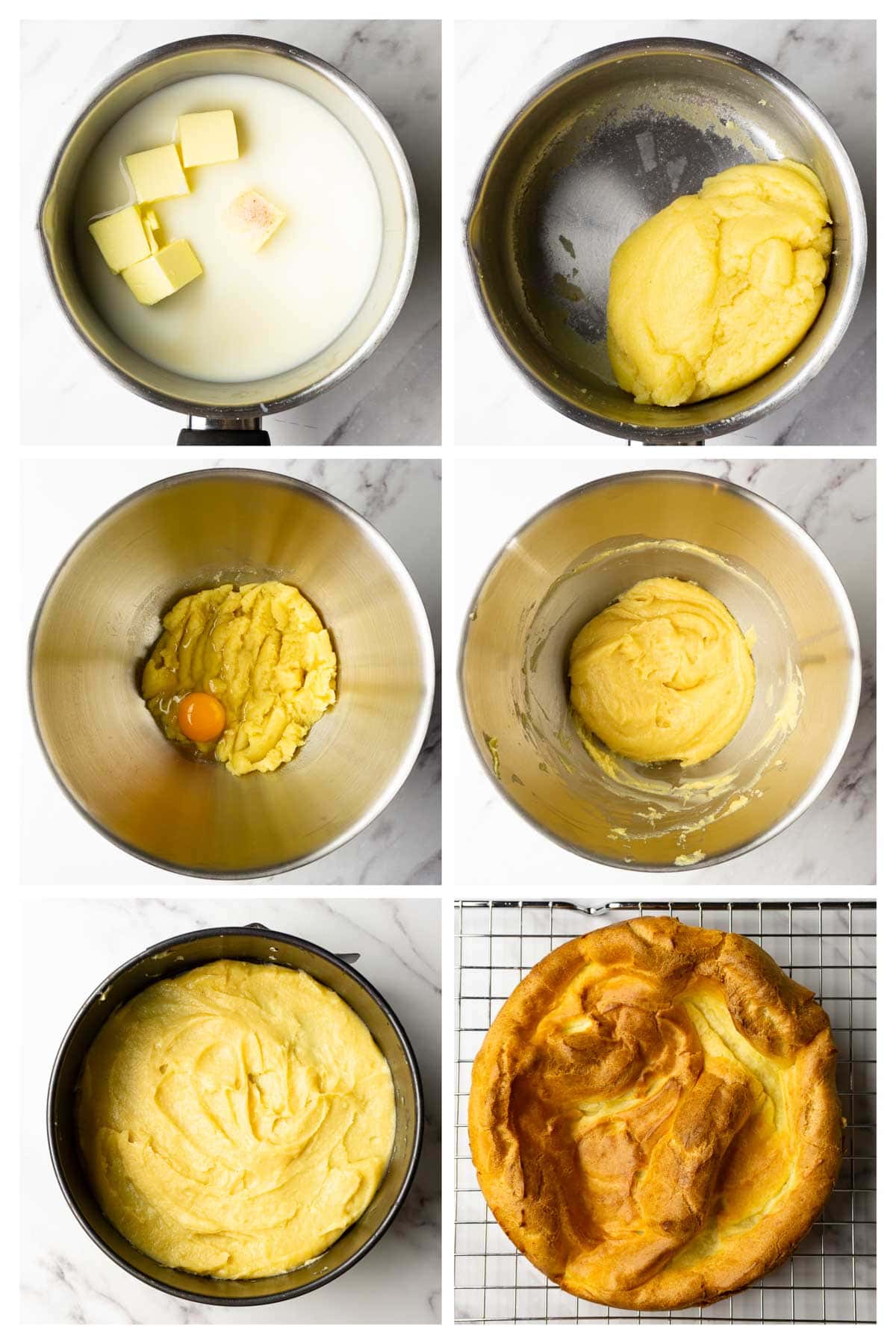
4. Cook for 2 minutes until the dough forms a ball and leaves a pale residue on the bottom of the saucepan.
5. Place the dough into a mixing bowl or a stand mixer fitted with a paddle attachment and let it cool down for 10 minutes. Then, add one egg and mix until fully incorporated. Repeat with the rest of the eggs.
6. Split the dough between two spring forms and spread it unevenly.
7. Bake for 25-30 minutes, or until reaching a deep golden-brown color on top. Cool down on the cooling rack completely before assembling our Polish cake.
For the filling
1. Place milk, half of the sugar, and salt into a saucepan and heat over medium heat until simmering.
2. Combine the second half of the sugar with cornstarch in a mixing bowl. Add the egg yolks and vanilla. Whisk until a homogenous consistency is reached without lumps.
3. Add approximately ½ of the hot milk to the egg yolk mixture while whisking vigorously to temper the eggs. Then, pour the egg mixture back into a saucepan with the rest of the hot milk.

4. Return to the heat. Cook over low heat for 5-7 minutes, whisking consistently until the mixture becomes pudding-like in consistency (this is so-called pastry cream or custard cream), then cook for 2 minutes. If lumps appear, whisk vigorously and they will dissolve.
5. Remove from the heat and pour the mixture into a large, shallow dish. Cover the pastry cream with plastic wrap so they touch each other, then leave it to cool down to room temperature.
6. In a stand mixer fitted with a whisk attachment (or use a hand mixer and a large mixing bowl), beat the butter with 15g of sugar until white and fluffy.
7. Whisk the pastry cream with a whisk until smooth again.
8. Add the pastry cream a couple of tablespoons at a time to the butter and whisk every time on medium until incorporated. Continue until all pastry cream is combined with the butter. Scrape the sides and the bottom of the bowl, then beat again for 10 seconds. Here you have your mousseline cream for Carpathian cream cake.
9. Assemble your Karpatka cake and chill. Then, dust with powdered sugar and serve.
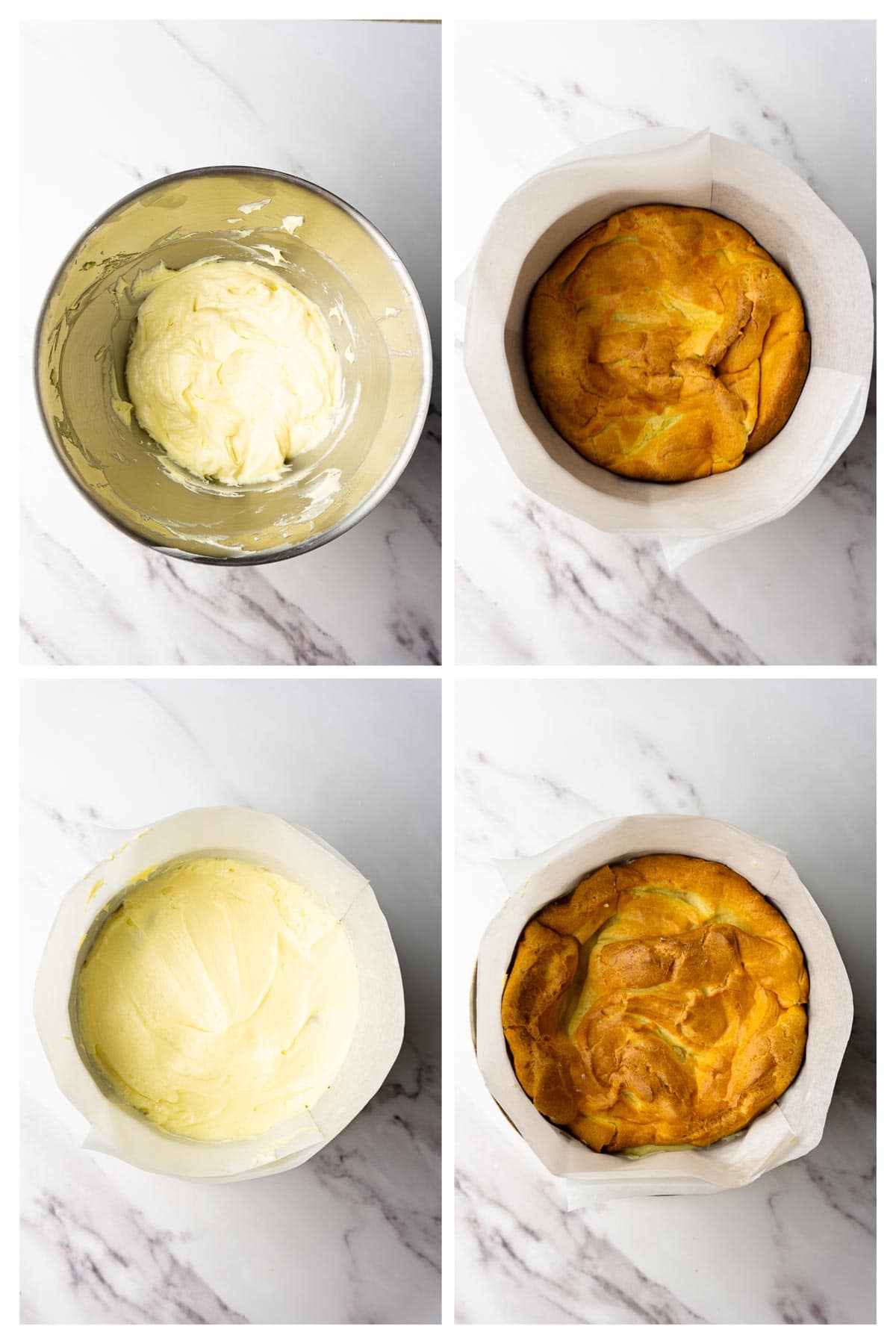
FAQ
It will last for up to 3 days. Also, you can make the choux pastry in advance and keep it in the fridge for 2-3 days, then bake.
You can freeze baked cake layers for up to 1 month but you can’t freeze the cream. It’s also not recommended to freeze unbaked choux pastry.

More dessert recipes
Recipe card
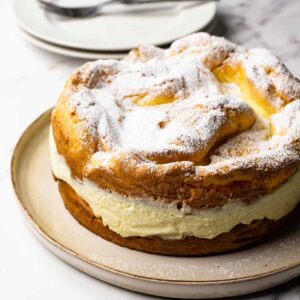
Karpatka
Equipment
- Rubber spatula
- Stand mixer
- Digital kitchen scale
- 23cm/9-inch springform pan
Ingredients
For the dough
- 75 ml whole milk
- 75 ml water
- 75 g unsalted butter
- 1 tablespoon sugar
- 1 teaspoon salt
- ½ teaspoon vanilla extract
- 100 g all-purpose flour sifted
- 170 g 3 large eggs at room temperature, the eggs should be weighed without shells
For the cream
- 600 ml whole milk
- 160 g granulated sugar
- ½ teaspoon salt
- 50 g cornstarch sifted
- 1 teaspoon vanilla extract
- 4 egg yolks of large eggs at room temperature
- 200 g unsalted butter at room temperature
- 15 g granulated sugar to beat with the butter
- Powdered sugar for decoration
Instructions
For the dough
- Preheat the oven to 200C/390F (top and bottom heat, no fan). Line the bottoms of two 23cm/9-inch springform pans with parchment paper and grease the sides with butter or cooking spray. If you have only one springform, you will need to bake one layer of the cake and then prepare the form again to bake the second layer.
- In a saucepan, combine water, milk, unsalted butter, sugar, salt, and vanilla extract, then heat over medium heat until it starts simmering. Remove from the heat and add the sifted flour. Mix until no dry flour is left, bring back to the heat, and set it to low.
- Cook the dough, mixing with a rubber spatula continuously for 2 minutes or until the dough forms a ball and the bottom of the saucepan is covered with white residue. Remove from the heat.
- Place the dough into a large mixing bowl or the bowl of a stand mixer fitted with a paddle attachment. Let it cool down for 10 minutes or until it’s no longer hot to touch but still very warm.
- Start by adding the eggs a little at a time and mix with a hand mixer, a stand mixer with a paddle attachment, or even by hand using a wooden spoon, until they are fully incorporated. Then, add more eggs and repeat until all the eggs have been incorporated. Scrape the sides and the bottom of the bowl and beat one last time for just a few seconds to ensure thorough mixing. The dough should be smooth. When you lift the paddle, it should slowly fall from it, leaving a V-shaped tail. The dough should be firm enough to hold its shape. If you achieve this texture before all the eggs have been incorporated, stop adding them. If the texture isn't there yet after you've added all the eggs, you may need to add an extra ¼ to 1 egg.
- Split the dough into two even parts and spread unevenly between two prepared spring forms. This unevenness will create random bubbles on the surface of the cake layers during the baking, which represent the Carpathian mountains. If you’re using one spring form, cover the second part of the dough with a plastic wrap while the first part is baking.
- Bake for 25-27 minutes or until reaching a deep, even golden-brown color on top. Remove from the oven and leave to cool down for 10 minutes before removing it from the form onto a cooling rack to cool down completely. Repeat the process if using only one spring form.
For the cream
- Place milk, half of the sugar, and salt into a saucepan and heat over medium heat until simmering.
- Meanwhile, combine the second half of the sugar with the cornstarch in a heatproof mixing bowl, then add the egg yolks and vanilla. Whisk until a homogenous consistency is reached without cornstarch lumps.
- When the milk start simmering, remove from the heat and slowly add approximately ½ of it to the egg yolk mixture while whisking vigorously to temper the eggs. Then, pour the egg mixture back into a saucepan with the hot milk.
- Cook over low heat for 5-9 minutes, whisking consistently until the mixture become pudding-like in consistency, then cook for about 2 minutes. Don’t stop whisking. If lumps appear, whisk vigorously and they will dissolve.
- Remove from the heat and pour the mixture into a large, shallow dish. Cover the pastry cream with plastic wrap so they touch each other and let it cool down to room temperature. You can place it into the fridge to speed up the process. However, if you cool it down too much, you need to bring it back to room temperature before the next step.
- In a stand mixer fitted with a whisk attachment (or use a hand mixer and a large mixing bowl), beat the butter at room temperature with 15g of sugar until white and fluffy.
- Whisk the pastry cream (IMPORTANT! The pastry cream should be at room temperature at this point or it won’t mix well with the butter) until it becomes smooth again.
- Then, add the pastry cream a couple of tablespoons at a time to the butter and whisk every time on medium until incorporated. Continue until all pastry cream is combined with the butter. Scrape the sides and the bottom of the bowl, then beat again for 10 seconds.
Assembling the cake
- Onto a serving plate, place the clean ring from the spring form that you used to bake the cake layers. Cover the sides inside the ring with parchment paper, if desired, as it will make it easier to release the cake after chilling.
- Place the first layer (the one that is less puffed up) inside. Press slightly to make it flatter.
- Place all cream on top and even it out.
- Cover with the top layer and press a little bit to attach it. Then, refrigerate for 2-3 hours or until the cream has set. Remove from the ring, peal the parchment paper if used, dust with powdered sugar, and serve.

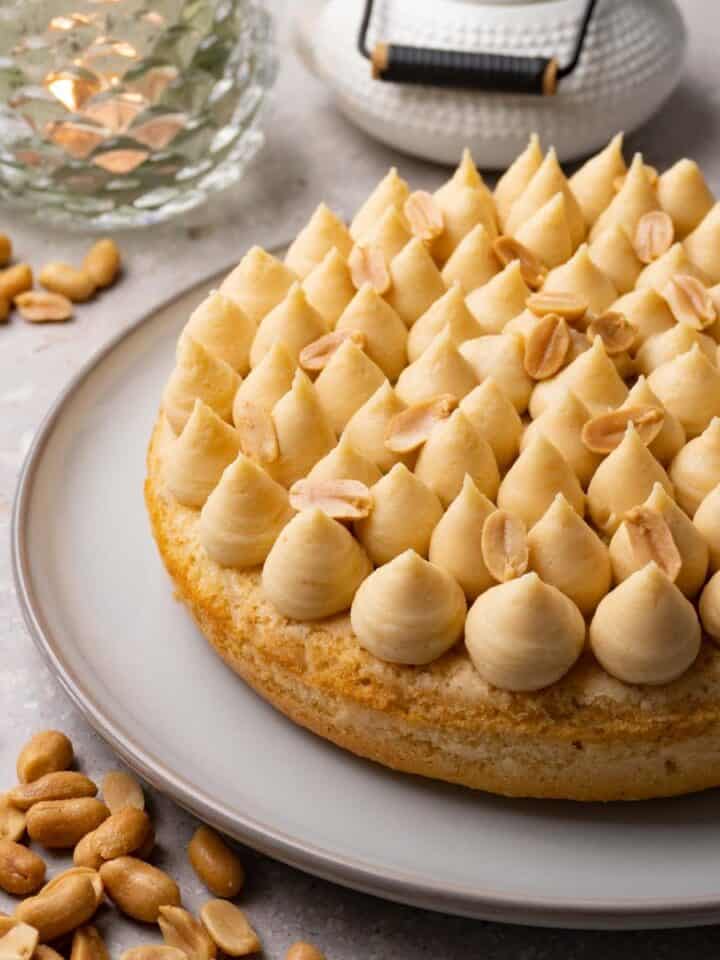
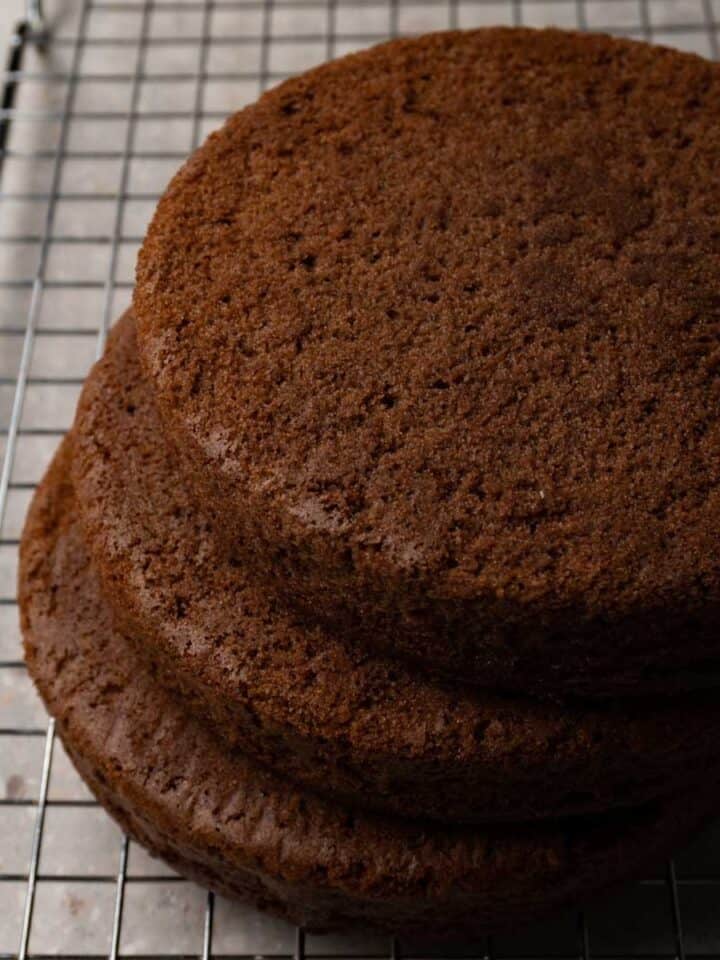
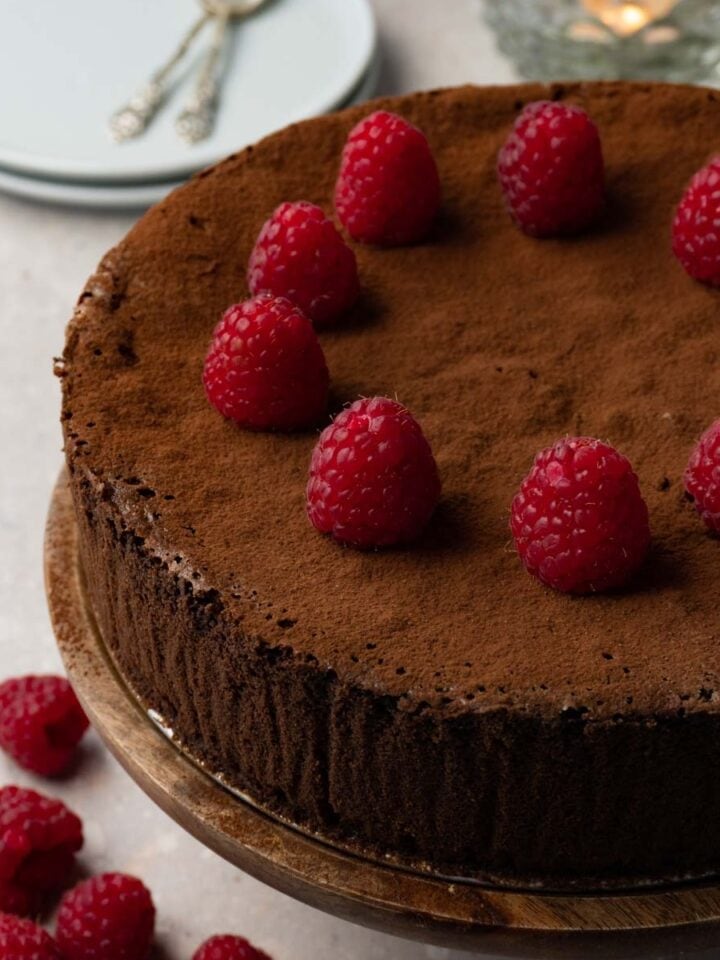
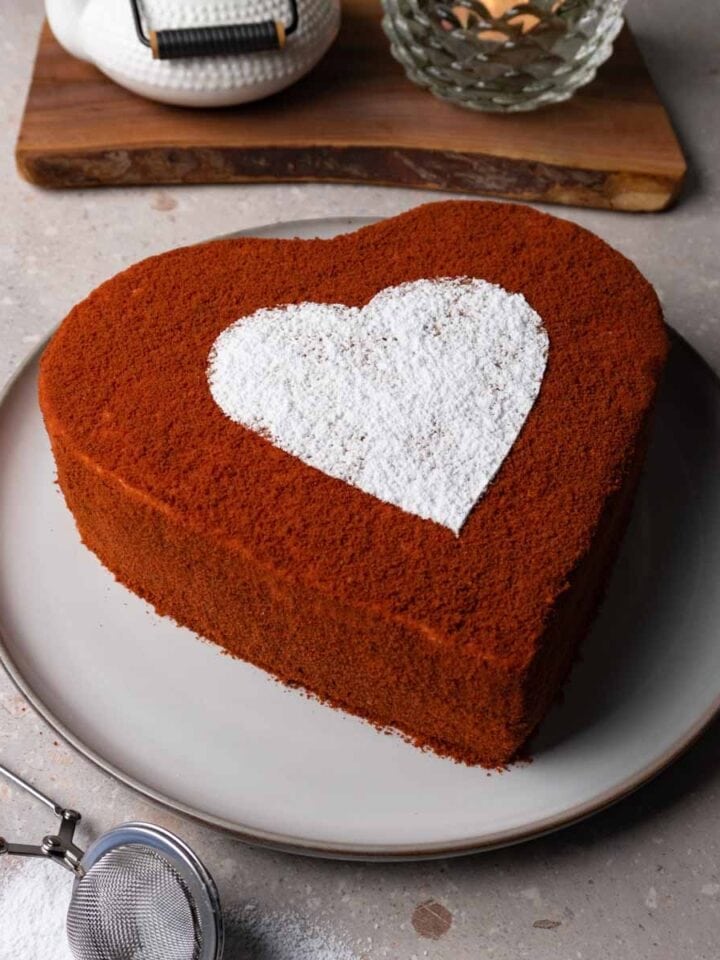
Lora
It’s like a big eclair in form of a cake! I made it twice and every time it was a hit!
Tatiana A Brown
It looks fantastic, reminds me of my aunt Halina who used go make a cake just like this for birthdays when i was young. I could never get it to taste as good. Will try, thanks for the step by step instructions.
Anna
Thank you for your comment, Tatiana. I hope you'll like this cake!
Christah
I took lots of time to make this for the first time yesterday . While we love the flavor and the cream. My dough was not like yours. When cooking the ball
Of dough on the stove, it never left a white film on the pot. So I cooked it for about 7 minutes in a ball, stirring. I finally put it into the mixing bowl. I added each egg as instructed . The batter was thin . I divided it into 2 batches. It made very thin sense flat layers after baked. How can I get it softer, fluffier and lighter ?
Anna
Hi Christah! Thank you for trying my recipe, and I'm glad you liked the flavors. Did you weigh all the ingredients using a digital kitchen scale or cups? Choux pastry likes precision, so measuring ingredients with cups can be the reason why your choux pastry didn't turn out right.
Sometimes, you can't see a white film while cooking choux pastry. It largely depends on your saucepan. That's why I mention that you should cook it for 2 minutes. Cooking for 7 minutes is way too long and can make your dough the wrong consistency.
When done correctly, the dough should look glossy and thick. It should fall slowly from a spatula or the paddle attachment of your stand mixer when lifted, leaving V shape tail. You can see it on the video inside the recipe card.
If you have more questions, feel free to ask!
MW
Unfortunately neither the dough nor the cream turned out. My husband has made plenty of eclairs successfully but this did not. It was too funny in spite of cooking it the time given. I made the cream and it never did thicken up. We weighed the ingredients.
Maybe we can try this with our tried and true recipes for eclairs and a assemble it like this. So sad.
Anna
I’m so sorry this recipe didn’t work for you! If your cream turned out runny, your pastry cream was too warm when you started adding the butter.
As for the dough, I didn’t understand from your comment what went wrong. This is a standard choux pastry recipe and I also use it to make cream puffs recipe that you can find on this blog.
Additionally, you can watch the video in the recipe card showing every single step of the recipe.
Bianca
Thank you for this recipe and the video, made it easy to follow! I do agree with some other comments about the thickness of the pastry cream though, I found I had to add about 4 more tablespoons of cornstarch once it was cooking (made a slurry) for it to get thicker, but it still never reached the consistency shown in your video. Luckily it did firm up though (I was determined to not let hours of work go to waste haha!). I also had to double the choux pastry as the original amount didn't make enough to get 2 decent rounds out for the pan size indicated. But overall, it turned out really nicely! Just think the recipe could probably use some tweaking.
Anna
I just went ahead and made the cake layers one more time to show that this recipe works. I attached photos that I took while making them just one hour ago. As you can see, I used a 9" springform pan, and I didn't need to double the recipe. Also, look at the texture! It’s fluffy and cooked through, and the exterior looks exactly like on the photos in the recipe post!
The total weight of the dough ingredients is around 510g. After cooking in a saucepan, some liquids evaporated, leaving me with 470g of the dough. It was enough to make two cake layers without doubling the recipe.
Same for the pastry cream, no need to increase the amount of anything. I use 50g of starch which is 8,3% of the total amount of milk in the recipe. It is enough to achieve the right consistency. The cream will become even thicker while cooling down. Adding more (almost doubling) cornstarch ruins the texture and taste.
I spent so much time putting together this recipe, shooting and editing the video, and providing process shots and useful information. This recipe doesn’t need any tweaking, it works every time if you follow it carefully.
Andrea
It was time consuming but worth the effort and I did use my kitchen scale for the ingredients. I did not have the correct size spring form so just used regular 9in cake pans and it worked. The only thing was that I didn’t have a pan to assemble it in but my custard was thick enough to hold the shape I spread it in and I was careful not to go all the way to the outside just to make sure it didn’t ooze out. I can’t wait to have it for dessert tonight. It’s not an incredibly tall cake. Mine is about 2 inches thick. If you want thicker, try an 8in pan possibly. Very good recipe!
Anna
Thank you so much for your comment, Andrea! Amazing that you like the cake 🙂
Ellen
Hi Anna.
Thank you so much for sharing this recipe with us! I made this cake over 2.5 days for my birthday. It tasted delicious! I have pictures but couldn't figure out how to attach them to this comment. For flavour I would give this recipe 4 stars, the flavours are subtle (not sickly sweet) and range along a spectrum of cream and custard to vanilla to the buttery decadence of choux.
I also wanted to share my experiences of the cooking process.
THE CREAM
From reading the other comments, I expected to have a lot of trouble with the preparation of the cream. Specifically, people seemed to have difficulties with thickening the cream. I can tell that you've invested a lot of time and effort into testing and developing the recipe, which makes me wonder if people are varying the ingredients that they are using or aren't thinking about the functions of the ingredients.
1. Firstly, are people heating the cream in Step 4 high enough to activate the thickener? "Cornstarch needs heat (in the ballpark of 95°C/203°F) in order for “starch gelatinization”—that is, the scientific process in which starch granules swell and absorb water—to occur. In other words, if you don't heat your cornstarch to a high enough temperature, your mixture will never thicken." (Quoted from Bonappetit - "Cornstarch Is a Powerful Tool That Must Be Used Responsibly" by Sarah Jampel)
2. Secondly, is the cornstarch or cornflour made from maize? Proper cornstarch is made from maize. Some countries (in my case, Australia) have, confusingly, made cornstarch from wheat and yet it is still called 'Cornflour'. Cornflour/Cornstarch made from wheat cannot be used in the same way or same amounts as cornstarch made from maize. Similarly, if one is using a different thickener like wheat flour/tapioca flour/potato starch the person using these variations is responsible for questioning and researching whether these are straight 1:1 substitutions and how well they will react to the cooking process (some thickeners don't react well to heat, some aren't stable after heating).
In my case, I used Cornflour (made from Maize) in the exact amount suggested (50g) and the cream thickened to a pudding-like consistency beautifully.
THE DOUGH
I wish I could attach a picture of the end result of my dough!
Basically, the dough developed into two slightly rippled (but mostly flat) discs. The texture was not light and fluffly, there was a slight puff, but on the top and bottom there was a firm crust. I used plain (all-purpose) flour with a 10.9% protein content which is mid-strength for gluten production in the exact measured amount listed. After cooking, I had 463g of choux, an 8g discrepancy from your measurement. I suspect this was my first mistake, I'm guessing I slightly overcooked the choux in the saucepan. The second mistake, I suspect, was that I did not immediately bake these layers, as I was making this ahead of time, I stored the choux in the fridge overnight. My understanding is that when you place a yeasted dough in the fridge it also slows yeast activity. However, apart from the wild yeast present in all flours, this was an unyeasted dough so I'm unsure if this was an issue. I also was unsure whether the oven temperature provided was for a conventional or fan-forced oven so to be safe I baked at 180C/356F instead of 200C/390F. But since I had to bake longer to develop that golden-brown colour I'm guessing this was a fan-forced measurement and I was overly cautious!
TDLR: So I have no idea why my dough turned into two flat discs. It was one or more of the following:
- Should've used a lighter flour, like pastry flour (8% protein content) for flaky result.
- Might have overcooked in the saucepan which resulted in a smaller amount of dough.
- Should've baked the layers immediately instead of storing dough in the fridge overnight as this may have affected some chemical reaction I am unfamiliar with.
- Maybe my oven hates me.
- Does anyone have any ideas about why my layers did not behave?
I better conclude this way too long comment, but I thought someone might learn something from my successes and failures.
All up, I really really enjoyed baking and eating this cake 🙂 Thank you for sharing this recipe with us Anna.
Anna
Hi Ellen! First of all, thank you for investing your time in writing this comment. I really appreciate it, and I'm happy to hear about your experience with my recipe!
About the cream. You did everything correctly, although you should use cornstarch, not flour. However, I know that some countries use cornstarch and corn flour definitions interchangeably. So, I assume you actually used cornstarch (it's white), but you call it corn flour in Australia.
About the dough. You used the right type of flour, so there's no mistake here. Also, the choux pastry can be refrigerated overnight if tightly wrapped in plastic wrap, so this should not affect the result. Where you may have made a mistake, however, is when you cooked the dough. Maybe you overcooked it a little bit. But the main reason your dough didn't puff up as it should is the temperature inside your oven. It should be preheated to 200C (390F) bottom and top heat, with no fan. I will add this information to my recipe card.
Virginia Lepp
I find that if you “overcook” the choux paste in the saucepan you might need more eggs. I typically put in one less egg than the recipe states. Then start adding eggs 1/2 at a time until the consistency is correct. In my experience it’s the amount of egg that messes people up. This tactic corrects that problem.
Anna
Yes, you are right! But it's not only about how long you are cooking the dough, but also about what flour you use. All-purpose flour from two different brands won't be the same "thirsty," so you may need to adjust the amount of egg you use. However, if you weigh all your ingredients, including eggs without shells, and cook your choux paste for not more than 2 minutes, as mentioned in the recipe, then 170g of eggs should be enough to make a perfect dough. Of course, it's best to follow visual cues and watch for the dough that slowly drops from a spatula or a paddle attachment, leaving a distinct V-shaped tail.
Eve
wow, amazing
Anna
Thank you!
Meagan
Definitely going to have to try this! My husband isn't Polish, but he is from Europe (The Netherlands) and this dessert is RIGHT up his alley! Can't wait to make it!
Anna
I hope you and your husband will like the cake!
Harold Lane
As my digital kitchen weighted-thingy went wonky. I bought a new one. Weighing ingredients is a key. Your directions are spot-on. The outcome reminded me of a bakery I and my friends would visit when we snuck out of church. The crème horns: these Mille-Feuille, have taken me back 55 years to a perfection I have dreamed about.
Anna
Thank you, Harold!
Cheryl
I have not yet tried your recipe, but I definitely will! It sounds similar in taste & technique to the cream puff recipe I make on occasion ( only because they are so good I can’t leave them alone!). Everything has to be measured & cooked till it looks right. So I am excited to give your cake recipe a try! I just had knee surgery, so I will have to wait a bit.
Cheryl
Anna
Hi Cheryl! You're absolutely right that the dough in this recipe is similar to what you'd use to make cream puffs. I wish you a speedy recovery and I hope you will give my recipe a try.
John Fun
hello, I made this for a Polish friend of mine (his birthday) and he was very impressed; me too; it tasted great and it looked fabulous.
thanks for the recipe, I added it to my collection of Polish dishes and will surely repeat it some day. too bad I can't post a picture of it.
Anna
Hi John! Thank you for your comment! I'm so glad that you and your friend liked the cake 🙂
George Moy
It looks good to make, but I wonder, if you don’t have two springform pans to use,could you use a 9 inch round cake pan for baking the cake layers instead?
Anna
Yes, you can use regular cake pans to make the cake layers! Just line the bottom with parchment paper and grease the sides with butter. You might also need to run a knife against the wall of the pans to release the cake layers if they stick a bit.
Lora
I think I enjoyed reading the precision of this recipe and the comment from Ellen as much as I would eating it. I don’t think I would attempt to make ibecause I don’t have that much time, but will save to try one day. Thank you for sharing.
Anna
I hope you'll try it one day! It takes around 1 hour and 30 minutes to make (not including chilling time for the pastry cream).
Kathleen
My cake was sooo good. The pastry cream is time consuming but well worth it.last step is to cream butter/ sugar with pastry cream . Both at room temp.when done you have a delicious fluffy rich creamy pastry cream.Follow recipe exactly as written you can’t go wrong.My Husband gave it 5 stars. Definitely will make again an again.
Anna
Thank you so much for your positive review, Kathleen! I'm glad you and your husband love the cake 🙂
Mike
This is the cousin of a Paris-Brest.
Ida
This is my first time making anything like this and it turned out so good!
I had to substitute 1/3 of the whole milk with oat milk as I ran out, but it still turned out perfect.
I was a little unsure how the choux layers were supposed to be in texture (crispy/soft etc). Mine were soft so I was initially concerned it was undercooked, but they were golden brown and definitely cooked through so I'm satisfied that it turned out correctly.
The custard is so delicious, I'm going to have to use it in other recipes too.
thank you!
Anna
Thank you for your comment, Ida! I'm so glad you like the cake 🙂
Marcia
This cake is incredibly easy to make and of course, super delicious! I made it yesterday and had no problems whatsoever. I used the US measurements and followed the instructions as written. Will definitely make this again. The recipe is going into my favorites🥰
Anna
I'm so happy you like the cake! Thank you for your comment, Marcia!
mary rivas
Can you please send the recipe In American measurements
Anna
I provide US measurements in every recipe you can see on my blog (which you can get access to by pressing the US customary button in the recipe cards). However, I recommend using metric measurements. Measuring ingredients by volume using cups is not accurate and can lead to all sorts of problems with your baked goods.
Nicole
Hello! I made the recipe, but had an issue with my dog eating half of one of my baked choux layers. Everything has worked out immensely well otherwise. I used salted butter for the cream and forgot to omit the salt. My cream therefore, is not sweet enough and is a bit salty. This is no fault of the recipe, but of the baker (myself)! I want to sweeten my chilled and finished cream. Should I whisk some sugar into some heavy whipping cream and fold it into my chilled cream? Or would you recommend adding more butter/sugar (whisked until white/fluffy) or would that add to the salt too much? Just trying to save what I have. I am bringing it tomorrow and need to finish/set it all up this evening.
Thank you!
Anna
Hi Nicole! What a naughty doggo you've got there, hehe.
You should definitely use unsalted butter for the cream, just as specified in the ingredient list. Using salted butter won't work because it would make the cream too salty, even if you skip adding extra salt.
Unfortunately, there's no way to fix the flavor of the cream since you've already mixed it with the butter. You'll need to start from scratch and rapidly cool down the custard base in the freezer. Keep a close eye on it, and use an instant-read thermometer to ensure it reaches room temperature and not colder!
Once you've whipped it with unsalted butter, assemble the cake and refrigerate it overnight since you plan to bring it tomorrow.
Hope it helps!
Amanda
I followed the recipe exactly and this delectable cake came out perfectly. It was a big hit at our Thanksgiving feast. I served it with a blackberry sauce. Divine.
Anna
Thank you for the positive review, Amanda! Blackberry sauce sounds so delicious with this cake 🙂
Kaley
I loved this recipe, though I weighed all the ingredients, I had to add extra flour and sugar to the dough to get it to a fluffy consistency on the stove. I never did get a white film in the pan even after adding an extra 1/2 a cup of sifted flour. It di eventually make a ball, just no film, so I went ahead and put it in my stand mixer and let it cool. Everything turned out great. My boys loved it.
Kim
Ummmmm......Yum! I made it today, it's really good! Thank you!
Anna
Glad you liked it, Kim!
Jennifer
Fun recipe to stretch my abilities! I wish I would have read the comments before making the recipe. I ended up making the cream again and it turned out beautifully! Cream step #4 states that it should be on low for 5 - 9 minutes. The comments correct this by stating that it needs to be at a temperature warm enough to activate the Starch to make it thicken. When I started over and put burner on 4 instead of low it thickened perfect!
Anna
Thank you for your comment, Jennifer! I'm glad you successfully made the cream! 'Low heat' can be interpreted differently by different people, and it also depends on the type of cooking surface used. On my induction cooktop, setting 4 is considered low heat, resulting in a few bubbles while cooking but no active simmering or boiling, which is perfect for making pastry cream.
Angela
Hello, thank you for the beautiful recipe. Have a celiac friend…any idea how successful this would be with gluten free flour or other substitute?
Thank you.
Anna
Hello, Angela! I know that it is possible to make choux pastry with gluten-free flour blend, but I'm not sure that it will work with my recipe. You might need to use different proportions of flour to liquids and eggs. My suggestion is that you find a gluten-free choux pastry recipe somewhere else and bake it as I suggest to create two cake layers. The cream is gluten-free, so you don't need to change anything there.
marilla
I cut the sugar in half in the creme - i find most american recipes way too sweet. this was just perfect - the sweetness and the bit of salt in the creme and the saltiness of the puff was just the way i wanted it..
Kyle
I’m in Denver and this recipe doesn’t work at all at high altitude. I’ve made the dough three times. The first time it turned into a runny batter when I added the exact right amount of egg. I tried baking it anyway and it just turned into a dense flat disc. Tried again, this time using less egg so I’d have the same consistency as the video. It still baked into a flat disc. The third time, I had the correct consistency, and I baked it at 25° hotter and 5 minutes less as is recommended for 5000 ft of altitude, and it still baked into a flat disc.
Anna
This recipe is for baking at 0-2000ft. It may work at 2500ft as well, but it needs to be tested. At altitudes higher than that, you need to change not only the baking temperature and time but also the amount of flour, fats, liquids, sugars, and eggs. Essentially, you would need another recipe.
If you had asked me beforehand whether this recipe would work at 5000ft, I would have given you suggestions on how to adjust it for high altitude.
Lara
I made this spectacular cake yesterday. Im a custard lover and this is possibly the most amazing cake I’ve ever eaten and made. I’m not a baker by any means and i was very intimated. But it turned out PERFECT and i am so very proud of myself! Thank you Ana for this perfect recipe, easy to follow, basic/not expensive ingredients and detailed instructions. I was worried about my pastry as it was a lot runnier than yours in the video, and I wasn’t sure if adding more eggs would’ve made it runnier, so i baked it as it was (for 32mins to try get it to your brown) and to my surprise both layers made ‘mountain peaks’. I will also never buy custard again, this was the most decadent almost white-chocolatey flavoured custard and i will be sure to make this as a dessert on its own. I wish i could show you a photo of my Karpatka.
Anna
Thank you for your comment, Lara!